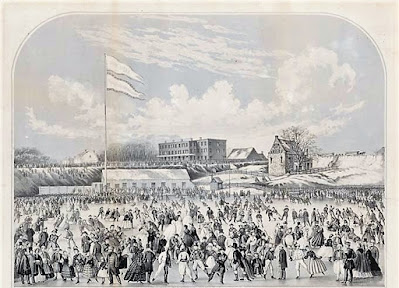The date was February 9, 1869, the place the Brooklyn Rink in New York and the event in question the Championships Of America. E.T. Goodrich and Frank Swift were both scheduled to compete, and in the days preceding the competition, weather and ice conditions had been favourable... but on the morning of the ninth, a wicked rain storm kicked up and a decision was reached to postpone the competition. Unfortunately, as there were no phone tree's or Twitter back in those days, not everyone was aware of the event's cancellation .So in the cold February rain, hundreds of Brooklyn residents flocked to the rink anyway. They took their skating seriously back in those days, didn't they?
Goodrich and Swift had both made the damp trek to the Brooklyn Rink despite the competition's cancellation, so they gave short exhibitions of their specialities... figures with names like grapevines, Mercury scuds and locomotives. Afterwards, the soggy ice was opened for skating to the general public, which included members of both the New York and Brooklyn Clubs. While many troupers took to the ice, others were content to continue to watch the best skaters from the sidelines.
An 1860's skating carnival in Brooklyn. Photo courtesy Museum Of The City Of New York.
Among those in attendance was a nineteenth century ice comedian named Jimmy Demorest who took it upon himself to lighten up a rather dreary situation. The February 20, 1869 issue of the "New York Clipper" explained how it all went down: "Apropos of Jimmy, an amusing incident occurred during the evening, of which he was the hero. Demorest's abilities as a comic skater coming to the ears of Mr. M. Chichester, superintendent of the rink, that gentleman procured an old suit of clothes for our hero, and proposed that he should go on the ice as a drunken man. To carry out the joke, it was determined to let no one in the secret, not even the policemen who had been detailed to preserve order on that particular evening. Accordingly, Jimmy rigged himself in a private room, got out of the window, and was let into the rink by a back door. Swift had just left the ice, the music had ceased, when a little stir at the lower end of the rink and several voices in angry dispute attracted attention to that direction. Presently a loaferish looking, half tipsy sort of chap tumbled on the ice, and commenced to gyrate in the most comical manner. The spectators laughed at the antics of the stranger, while others cried 'Put him out!' Superintendent Chichester, who was conveniently at hand, started after the intruder, but the fellow was too spry for him, and after several ineffectual attempts to lay hands on him, which were provocative of much merriment, Chichester called on the police officers to remove him. The metropolitans advanced on the chap with an air which seemed to convey that they had an easy job on hand. Demorest had, in the meantime, been 'wobbling' round, part of the time in the water and again trying to preserve his balance, his amusements all the time being of the most amusing character. As the over-vigilant guardians of the peace advanced with drawn clubs, Demorest dodged them very successfully, much to their chagrin. Finally, the farce being played out, Jimmy left the ice, and much to the surprise of the spectators and greatly to the disgust of the officers, slipped his coat and hat off and proceeded to the gentlemen's room. As he passed through the crowd and the people began to realize the fact that they had been sold, Demorest was greeted with applause."
This wasn't the only 'sell' back in those days. Back in 2015, we explored the story of how Callie C. Curtis donned his finest drag and successfully pulled the wool over the eyes of audiences and judges alike by entering women's skating competitions. Early American skating history in particular is peppered with many accounts of confidence tricksters such as these - rink owners and event organizers working with skaters - to manufacture publicity stunts which drew in spectators. In this particular case, it seemed to work!
Skate Guard is a blog dedicated to preserving the rich, colourful and fascinating history of figure skating. Over ten years, the blog has featured over a thousand free articles covering all aspects of the sport's history, as well as four compelling in-depth features. To read the latest articles, follow the blog on Facebook, Twitter, Pinterest and YouTube. If you enjoy Skate Guard, please show your support for this archive by ordering a copy of the figure skating reference books "The Almanac of Canadian Figure Skating", "Technical Merit: A History of Figure Skating Jumps" and "A Bibliography of Figure Skating": https://skateguard1.blogspot.com/p/buy-book.html.


